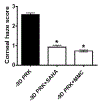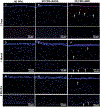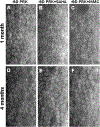Efficacy and Safety Comparison Between Suberoylanilide Hydroxamic Acid and Mitomycin C in Reducing the Risk of Corneal Haze After PRK Treatment In Vivo
- PMID: 29227512
- PMCID: PMC9248033
- DOI: 10.3928/1081597X-20170921-02
Efficacy and Safety Comparison Between Suberoylanilide Hydroxamic Acid and Mitomycin C in Reducing the Risk of Corneal Haze After PRK Treatment In Vivo
Abstract
Purpose: This study compared the efficacy and safety of suberoylanilide hydroxamic acid (SAHA) and mitomycin C (MMC) up to 4 months in the prevention of corneal haze induced by photorefractive keratectomy (PRK) in rabbits in vivo.
Methods: Corneal haze in rabbits was produced with -9.00 diopter PRK. A single application of SAHA (25 μM) or MMC (0.02%) was applied topically immediately after PRK. Effects of the two drugs were analyzed by slit-lamp microscope, specular microscope, TUNEL assay, and immunofluorescence.
Results: Single topical adjunct use of SAHA (25 μM) or MMC (0.02%) after PRK attenuated more than 95% corneal haze and myofibroblast formation (P < .001). SAHA did not reduce keratocyte density, cause keratocyte apoptosis, or increase immune cell infiltration compared to MMC (P < .01 or .001). Furthermore, SAHA dosing did not compromise corneal endothelial phenotype, density, or function in rabbit eyes, whereas MMC application did (P < .01 or .001).
Conclusions: SAHA and MMC significantly decreased corneal haze after PRK in rabbits in vivo. SAHA exhibited significantly reduced short- and long-term damage to the corneal endothelium compared to MMC in rabbits. SAHA is an effective and potentially safer alternative to MMC for the prevention of corneal haze after PRK. Clinical trials are warranted. [J Refract Surg. 2017;33(12):834-839.].
Copyright 2017, SLACK Incorporated.
Conflict of interest statement
The authors have no financial or proprietary interest in the materials presented herein.
Figures






References
-
- Jester JV, Ho-Chang J. Modulation of cultured corneal keratocyte phenotype by growth factors/cytokines control in vitro contractility and extracellular matrix contraction. Exp Eye Res. 2003;77:581–592. - PubMed
-
- Mohan RR, Hutcheon AE, Choi R, et al. Apoptosis, necrosis, proliferation, and myofibroblast generation in the stroma following LASIK and PRK. Exp Eye Res. 2003;76:71–87. - PubMed
Publication types
MeSH terms
Substances
Grants and funding
LinkOut - more resources
Full Text Sources
Other Literature Sources

